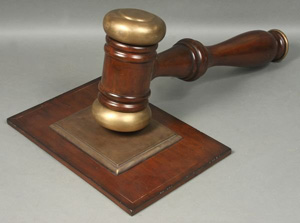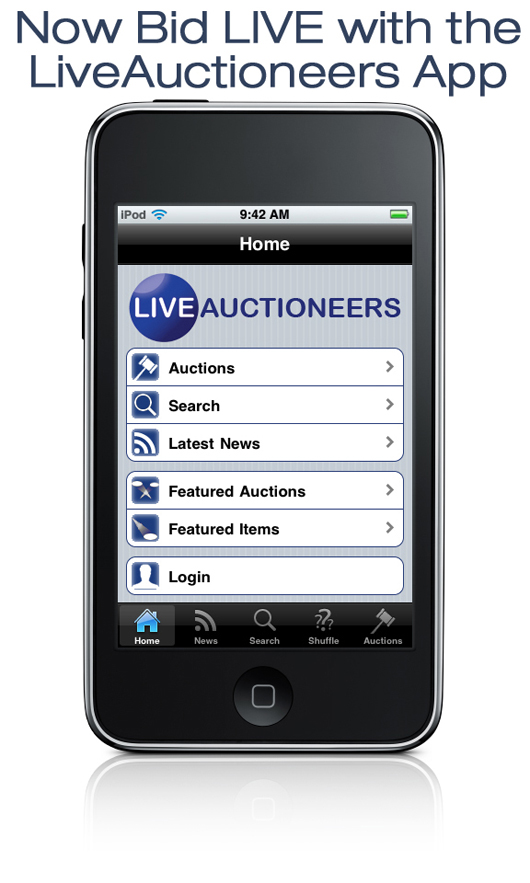
UPPER SADDLE RIVER, N.J. – “Sold!” the auctioneer calls out. This is the very moment when title legally changes hands from the owner (or consignor) of the property being sold. to the bidder who won the item.
The “bids” (the offers to purchase the item being sold) are the essential elements in any successful auction. These incremental bids by those who raise their paddles indicate to the auctioneer that they are making an offer to purchase the item.
The process of incremental bidding, i.e., a method by which bids are increased according to pre-determined increments, should be as simple as it sounds, and often is. This article deals with both the standard, everyday incremental bidding at an auction, as well as some of the vagaries of the process. It also deals with some things that bidders need to be aware of.
The numbered bid paddle (or card, or in some cases even a paper plate with a number written on it) is provided to the bidder once he or she has registered at the auction house. Registration is the process by which you supply the auction house with your identification, and any other required information, so they know who you are. Often, this requires a valid driver’s license.
Once registered and supplied with a bid paddle, bidders are given, or have the option of purchasing, a printed catalog that should include the auction’s Terms and Conditions of Sale. Read them carefully. The catalog usually contains the listing of all the items being sold, the lot number assigned to each item, detailed descriptions of the property being offered and sometimes condition reports that describe such things as repairs, breaks, etc.
The catalog may also contain an estimate of each item’s value. These values are based on the auction house’s research of historical selling prices of similar items. These estimates are often represented in ranges such as $200-$300, $400-600, etc. Most items eventually sell in or near these estimate ranges.
Now that you’re armed with your bid number and catalog, you have everything you need to move along to the next step of the process, the all-important pre-auction inspection, or preview. As you go from item to item and identify those pieces that may interest you, the catalog is an excellent in-hand reference. Refer to it frequently, as it may supply you with information you might not be aware of. Many buyers also use the catalog to circle items of interest, jot down their maximum bids (how high they are willing go), general notes, etc.
Once you take your seat and the actual auction begins, the paddle is used to indicate to the auctioneer that you are making an offer to purchase, or bid. The auctioneer will often begin by asking for a low opening bid from the audience, often one-half of the low estimate of the item being sold. Once someone’s paddle is raised into the air, the bidding process begins, and it continues to progress until the item is deemed “sold.”
For example, an opening bid of $100 is often followed with a subsequent bid of $125, then $150, and so on, as the bidding process continues. The advances in the bids usually follow pre-determined bidding increments. At Leighton Galleries, as an example, the increments are published in the catalog, and range from $10 bid increments for items selling for $10 to $100, to $100 increments for items selling for $1,000 to $5,000.
If the auctioneer opened an item by asking for a $100 bid, and you raised you paddle, the auctioneer would acknowledge your bid and, in the same breath, start looking for $125 from someone else. Then, if that someone else were to raise their paddle, the auctioneer would acknowledge that bid and almost certainly look right back at you for the next bid, now at $150. If you were to bid again, he would look back at the other bidder (called the underbidder) for the next bid, and so on, until one of you stops bidding. The sale happens when no additional bid, or advance, is made beyond the last and final bid. At that point, the auctioneer calls “Sold!” and moves on to the next item, repeating the entire process.
Sometimes in the heat of the auction, a bidder will call out a bid in excess of the bid that the auctioneer is asking for. Say the auctioneer is trying to get a bid for $225, and a bidder raises his paddle and yells out “$300”, this is referred to as “jumping” the bid. This is an aggressive move on the part of the jump bidder, an attempt to intimidate the underbidder into capitulating. This move sometimes works, but sometimes it can also fuel unintended competition.
Another bidding tactic used by determined buyers is to raise their paddle into the air, and leave it there, holding it up through the entire bidding sequence. The motivation to bid in this way varies from person to person, and for a variety of reasons. At our auctions, I personally appreciate this type of bidder since it helps to move the sale along. However, for those who might consider bidding in this way, be forewarned. Unscrupulous auctioneers might see this “paddle-in-the-air” bidder as an easy mark, as it indicates a relentless bidder who will not stop bidding until he wins the item.
I’ve seen this illegal practice myself, many times. Bidding in this manner opens the door to a dishonest auctioneer “bouncing” bids (taking nonexistent bids from the floor, the back of the auction hall, out of the air, etc.) and running up the price to the detriment of the paddle-in-the-air bidder. This bouncing will continue until the paddle comes down or the bidder shows some hesitation. Then, and magically, the “underbidder” stops bidding and the paddle-in- the-air buyer wins the item, ultimately paying far more than the real bidding justified.
One victim at a particular auction, who was bidding on a reproduction Tiffany lamp, happened to be a long-time customer of Leighton Galleries. I didn’t even know he and his wife were there until I looked around to see who was bidding so high on this reproduction lamp. As an auctioneer myself, I’ve developed a keen eye for picking bids out of an audience. A blinking eye here, a tipped catalog there, the nod of a head – I have seen them all. I stood at the front of the auction hall and believe me, there wasn’t another bidder is the house – except my customer and his wife. Not one!
This buyer grossly overpaid as a result of a dishonest and greedy auctioneer. I immediately told my customer. I cautioned him that he could bid that way at MY auction without any apprehension, but to be careful at THIS auction because he was the only bidder on the lamp; the others were phantom bids. I later learned that this particular auctioneer had been arrested and his auction business closed down for similar indiscretions.
Finally, bidders should be aware that they may find themselves competing with legitimate bidders who aren’t physically present in the auction gallery. For a long time, now, telephone bids have been a staple at auctions. Essentially the bidder on the other end of the phone is bidding just as if they were in the hall, with the auction staff communicating with them on the phone and bidding on their behalf.
Absentee bids, or bids left with the auction house, are fairly common as well. Absentee bidders are folks who can’t attend the auction due to scheduling conflicts, geography, or just not wanting to spend the evening waiting for a few items to come up for bid. In this case, they fill out a form and tell us how high they want to bid. The auction house then bids on their behalf in a competitive fashion.
Most auction houses impose minimum-bid requirements on absentee and phone bidders to justify the extra time their employees must invest in handling the bids. For instance, if a phone bidder wants to bid $100 on a sapphire ring of obviously greater value, most auction houses will not take the bid. A $1,000 bid on a bronze is a completely different circumstance.
The Internet has shaken up the auction business in recent years in ways never before imagined. These days, buyers can sit at their computer at home, in their office, or anywhere in the world for that matter, and participate by entering bids through their computer [or, if using LiveAuctioneers.com, also via apps downloadable to their iPhone, iPod Touch or Android phone; absentee only through BlackBerry]. They can leave bids just like a traditional absentee bidder, and we bid on their behalf. The Internet also allows bidders to bid in real time through the Internet, as though they were right there in the hall or on the phone. As the item comes across the screen on their computer, all they have to do is click on a BID button, and voila. Internet bidding has become so popular that in most of our auctions, more than 35% of the items sell to the Internet.
If you are new to auctions and are thinking about attending one, find a local auction, register if you choose to do so, or simply take a seat and watch. Alternatively, learn the ropes by monitoring an auction through LiveAuctioneers.com. It’s absolutely free to watch any sale in progress on LiveAuctioneers. The process is so simple, you’ll catch on quickly. Within a few minutes of watching an action, you’ll be ready to jump right in with confidence.
Auctions are an excellent way to buy everything and anything from jewelry to antiques to collections of all kinds. You decide what you’re going to pay, and it’s fun too!
John Merowski
Owner/Auctioneer – Leighton Galleries Inc.
# # #
ADDITIONAL IMAGE OF NOTE


